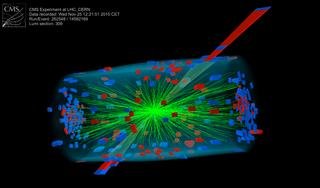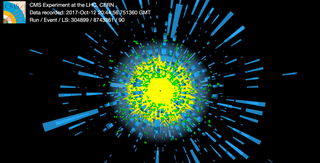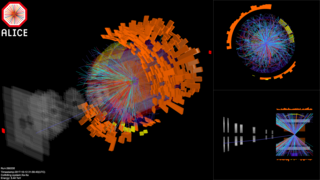Smashing xenon beams at the Large Hadron Collider at CERN
The Large Hadron Collider (the LHC), at CERN, is the high-energy physics complex where the major particle physics experiments of these days are on-going. It is well known as a machine where proton beams are smashed against each other at very high energy (and I already discussed this many times on my blog).
But protons are not the only beasts that are accelerated and collided at the LHC!
Other much heavier particles are indeed also collided, and they actually leave amazing records in the detectors. Heavier particles means more matter and thus potentially much more tracks in the detectors, as shown with the example of the picture below where each colored line or cell represents a detector hit.
But let us go back 5 minutes to the proton case. The motivations for colliding protons at the LHC are twofold.

[image credits: ALICE@CERN]
First, one aims to understand better the Standard Model of particle physics. In a few words, physicists are trying to confront the standard theory to data at an unprecedented level of precision.
There is in particular a large focus on the Higgs sector. The Higgs boson has been recently discovered, and some of his properties are still missing precise measurements today.
The second important motivation for the proton-proton collision runs of the LHC concerns the possible discovery of new phenomena.
Protons are accelerated at huge speeds, which make them very energetic so that it opens the door for discovering new particles or weird phenomena that appear only at higher energies.
Equivalently said, the physics opportunities originating from proton collisions are numerous and it is cool that most of the LHC operation time is dedicated to protons. However, protons are not the only objects that are collided at the LHC and there is a very good reason for that.
COLLIDING HEAVY PARTICLES AT THE LHC
A few weeks per year, the LHC enters a phase where heavy ions, instead of protons, are accelerated and collided in the LHC complex.
Whereas atoms are neutral, an ion is a similar object but with a non-zero electric charge. We can thus see an ion as a kind of atom, in which the number of electrons is not equal to the number of protons.
In the case of the heavy ions that are collided at the LHC, we are considering atoms in which the number of protons is large (several tens of protons, which explains the wording ‘heavy’) and where all the electrons have been removed from the initial atom.
Furthermore, until very recently, only lead ions had been collided at the LHC.

[image credits: CMS@CERN]
In practice, the lead nucleus beam is prepared from lead atoms. A dedicated apparatus takes care of stripping the atoms from their electrons, so that one ends up with a beam of lead atomic nuclei. Those beams are then injected in the LHC, accelerated and finally collided.
The idea behind colliding such nuclei is that one reproduces the conditions of the very early stage of the universe.
During the very first few millionths of second, the universe was constituted of a very hot and dense ‘soup’ of quarks and gluons, the most inner constituents of matter. By smashing lead nuclei, one gets the high temperatures and densities featured by this soup of particles that can thus be studied.
This contrasts with the usual state of matter that one finds today, where quarks and gluons are bound together and not visible freely. We can indeed only observe the resulting composite states (protons, neutrons, etc.).
With heavy ion collisions, physicists expect to study and understand better the very first moments of the life of the universe. In particular, one targets how quarks and gluons form this soup, or plasma as it is called in our jargon and collectively interact with each other.
XENON AT WORK

[image credits: CERN]
In the context of another experiment run at CERN, a large amount of xenon nuclei was prepared.
Physicists have then decided to undertake a non-expected run of collisions at the LHC: filling the accelerator with beams of xenon nuclei and smashing these beams against each other to see what comes out of it.
This originates from the results recorded so far during the heavy-ion running mode of the LHC, which were amazing. The previous LHC heavy ion run were indeed extremely successful in terms of physics outcome.
This has motivated physicists to try colliding two beams of xenon nuclei in the LHC.
There are new things to lean here, and now two months of LHC operation have been made available for that.
Xenon nuclei are much lighter than lead nuclei (129 neutrons and protons versus 208 for the lead case). We could therefore get access to an energy regime intermediate between the proton-proton case and the lead-lead case.

[image credits: CERN]
New LHC xenon data will allow physicists to investigate theories about LHC beams evolution (in terms of their constituents) and how beams interact with the LHC machinery.
Moreover, one will get more insights on ultra-peripheral collisions, i.e collisions in which the two colliding objects are well separated from each other.
In this case, the objects are not smashed against each other and the strong force is not the key player of the collision event. The two colliding particles can here be seen as roughly missing each other instead, so that only electromagnetic interactions take place (like photon-ion or photon-photon interactions). This corresponds to another type of collisions from which new things could be learned.
SUMMARY AND REFERENCES
In this article, I was aiming to emphasize one of the striking LHC events of last month: the LHC has started to collide xenon nuclei instead of protons or lead nuclei, as it was the case in the past.
This mode of operation will last for 8 weeks and will allow physicists to understand better the behavior of the LHC beams in terms of their constituents and how they interact with the accelerating device.
Moreover, the physics opportunities include the test of many physics process (in particular in the context of the so-called ultra-peripheral collisions) in a new energy regime.
More information can be found on the CERN report, as well as here for what concerns heavy ion collisions.
For more discussion on this topic (or anything related to science), please join us on steemSTEM. SteemSTEM is a community driven project which seeks to promote well written/informative Science Technology Engineering and Mathematics postings on Steemit. More information can be found on the @steemstem blog.
It's like looking at the remains of a car wreck and being able to identify what crashed into each other. Very interesting work. I enjoy learning about particle physics.
This is exactly what we do. Starting from the remains and going back to their source :)
It is quite interesting to make these collisions with the Xe, but do you have plans to collide with some other heavier element? @lemouth
Not to my knowledge. Actually, I was very surprized to read about xenon collisions in the first place, as the LHC was originally targeting proton-proton, proton-lead and lead-lead collisions only. The main matter here is to share the operation time amongst the different collision modes.
But lead didn't exist at the beginning of the Universe so fake news.
But seriously, super jealous you get to hang out with all these gluons
Ahaha! Actually, we reproduce the early universe conditions only during a very tiny moment. The plasma cools down fast :)
(not gluons, but quarks and gluons :p )
I may just be thinking semantically, but is it hard to get rid of the gluons? (I.e., are they sticky?)
Aha! You actually can't get rid of them as soon as you go deep inside matter (otherwise, they may be hidden) ;)
I remember my prof saying, "The smaller the particle you want to probe, the higher energy you want!".
This is right. More energy means a bigger microscope :)
It's been a while since I read any of your posts, and I must say the comprehensibility has gone way up! I understand almost everything you write now! :P
Good job!
Thank you. I must admit that my level of comprehensibility varies from one post to the other. Sometimes, I am so excited that I forgot that things I consider as the basics are not the basics from everyone (and I am always thankful to Steemians bringing me back to Earth) :)
I just want to remind again
Note: The Giant Hadron Collider (UK: Large Hadron Collider or LHC) is the world's largest high-energy particle accelerator, the most complex experimental facility ever constructed, and the largest single engine in the world.
Xenon is an element with the chemical symbol Xe, atomic number 54 and relative atomic mass. in the form of a noble gas, colorless, odorless and no taste.
Electrons = Electrons are subatomic particles that are negatively charged and are generally written as e-
Proton = Proton is a positively charged subatomic particle
Neutrons = Neutrons are parts of atoms that have a neutral charge
Why do you want to remind me this? What you said is correct, and I have never said anything different.
Is not the intention of reminding and blaming you, but i just want to repeat for readers who may not understand about physics. thank you
Aaaaah ok :)
Thanks for the clarification :)
Nice post I like this post thanks for sharing this post upvoted
Thanks!
There's a question I'd love to ask sir. It may sound like Sci-fi:
If these protons are accelerated at a high speed in the LHC, and there's a rupture in the LHC, can the explosion in the particle accelerator cause genetic transmutation in humans (like meta humans or mutants)?
The explosion would destroy the machine. That's it. How could it be harmful to humans we are not even close to the accelerator?
Ok sir. Thanks for the kind answer. Now I have to unlearn everything I think I know about particle accelerator.
Unlearn? Why? It is just this "danger thing" that is incorrect and exaggerated :)
Ok sir. Thanks for the response :)
wow,excellent view
Thank you!
Quite interesting, I have a made a CERN post as well perhaps you should check it out. An additional insight to further visualize what is CERN doing!
https://steemit.com/cern/@rldiamond/everyone-needs-to-pay-attention-to-this-cern-real-facts
I upvoted you maybe you can also return the favour ;)
I know what CERN is doing, and it is not what you say it does...